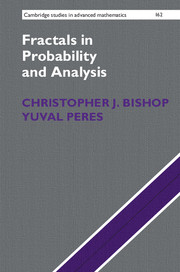Book contents
- Frontmatter
- Contents
- Preface
- 1 Minkowski and Hausdorff dimensions
- 2 Self-similarity and packing dimension
- 3 Frostman's theory and capacity
- 4 Self-affine sets
- 5 Graphs of continuous functions
- 6 Brownian motion, Part I
- 7 Brownian motion, Part II
- 8 Random walks, Markov chains and capacity
- 9 Besicovitch–Kakeya sets
- 10 The Traveling Salesman Theorem
- Appendix A Banach's Fixed-Point Theorem
- Appendix B Frostman's Lemma for analytic sets
- Appendix C Hints and solutions to selected exercises
- References
- Index
Preface
Published online by Cambridge University Press: 19 January 2017
- Frontmatter
- Contents
- Preface
- 1 Minkowski and Hausdorff dimensions
- 2 Self-similarity and packing dimension
- 3 Frostman's theory and capacity
- 4 Self-affine sets
- 5 Graphs of continuous functions
- 6 Brownian motion, Part I
- 7 Brownian motion, Part II
- 8 Random walks, Markov chains and capacity
- 9 Besicovitch–Kakeya sets
- 10 The Traveling Salesman Theorem
- Appendix A Banach's Fixed-Point Theorem
- Appendix B Frostman's Lemma for analytic sets
- Appendix C Hints and solutions to selected exercises
- References
- Index
Summary
The aim of this book is to acquaint readers with some fractal sets that arise naturally in probability and analysis, and the methods used to study them. The book is based on courses taught by the authors at Yale, Stony Brook University, the Hebrew University and UC Berkeley.We owe a great debt to our advisors, Peter Jones and Hillel Furstenberg; thus the book conveys some of their perspectives on the subject, as well as our own.
We have made an effort to keep the book self-contained. The only prerequisite is familiarity with measure theory and probability at the level acquired in a first graduate course. The book contains many exercises of varying difficulty. We have indicated with a “•” those for which a solution, or a hint, is given in Appendix C. A few sections are technically challenging and not needed for subsequent sections, so could be skipped in the presentation of a given chapter. We mark these with a “*” in the section title.
Acknowledgments: We are very grateful to Tonći Antunović, Subhroshekhar Ghosh and Liat Kessler for helpful comments and crucial editorial work. We also thank Ilgar Eroglu, Hrant Hakobyan, Michael Hochman, Nina Holden, Pertti Mattila, Elchanan Mossel, Boris Solomyak, Perla Sousi, Ryokichi Tanaka, Tatiana Toro, Bálint Virág, Samuel S. Watson, Yimin Xiao and Alex Zhai for useful comments. Richárd Balka carefully read the entire manuscript and provided hundreds of detailed corrections and suggestions. Many thanks to David Tranah and Sam Harrison at Cambridge University Press for numerous helpful suggestions.
Finally, we dedicate this book to our families: Cheryl, David and Emily Bishop, and Deborah, Alon and Noam Peres; without their support and understanding, it would have taken even longer to write.
- Type
- Chapter
- Information
- Fractals in Probability and Analysis , pp. xi - xiiPublisher: Cambridge University PressPrint publication year: 2016

